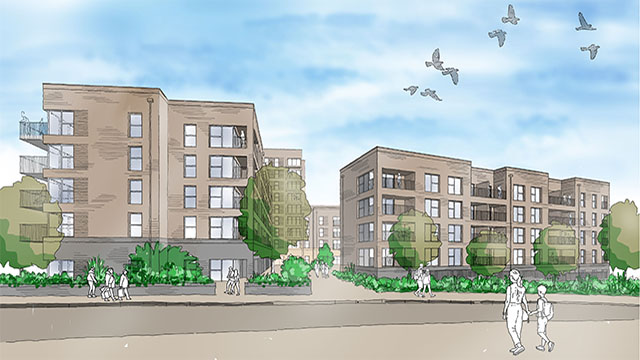Town and country planning – Planning permission – Fall back position – Claimant challenging decision of defendant local planning authority to grant planning permission for residential development on agricultural holding – Whether defendants adopting unlawful approach to fall back position – Whether defendants adopting unlawful approach to national planning policy framework – Whether defendants failing properly to consider effects of development on listed buildings and conservation area – Whether defendants failing properly to consider whether planning committee lacked jurisdiction to determine application – Claim dismissed
The defendant local authority granted planning permission to the interested parties to build four five bedroomed houses and associated access, parking and landscaping on land at Rocks Farm, The Rocks Road, East Malling in Kent. The claimant lived in a listed property next to the site which was on land designated in the local plan as countryside. Part of the land was a designated conservation area. The development site was part of an agricultural holding comprising a large agricultural building of 600m2 and a residential bungalow used by a caretaker. The development contemplated demolition of both buildings.
A report was prepared by the defendants’ officer which concluded that the starting point was the adopted development plan, against which other material planning considerations had to be given appropriate regard, including the requirements in the National Planning Policy Framework (NPPF), which was an important material consideration, and the planning and design of the proposal for the site in the context of the permitted development fall back position. The weight to attribute to each of those other considerations and the overall balance was ultimately a matter for the planning committee but the balance lay in favour of granting planning permission. The defendants resolved to approve the application in accordance with the officer’s report.
The claimant challenged that decision, contending that the defendants had: (i) adopted an unlawful approach to the fall back position and erred in finding that the existing agricultural building could be converted into three dwellings under permitted development rights; (ii) adopted an unlawful approach to the national planning policy framework (NPPF); (iii) failed properly to consider the effects of the development on listed buildings and the conservation area; and (iv) failed properly to consider whether the planning committee lacked jurisdiction to determine the application.
Held: The claim was dismissed.
(1) The claimant’s first argument turned on the proper construction of class Q of part 3 of Schedule 2 to the Town and Country Planning (General Permitted Development) (England) Order 2015 (the order), which provided for permitted development in the case of agricultural buildings; and on whether the defendants erred in concluding that there was more than a theoretical possibility of implementing a lawful fall back.
The proper construction of class Q was plainly a matter for the court. Paragraph Q.1(b) excluded such development where the cumulative floor space of the existing building changing use exceeded 450m2. The critical expression in paragraph Q.1(b) was “the existing building or buildings”. Paragraph 2 of the order defined “building” as “any part of a building”. Accordingly, the paragraph had to be read as meaning “the cumulative floor space of the existing building or any part of the building changing use”. If that was right, it was self-evident that the limit on floor space related only to that part of the building which was changing use.
The officer was entitled to conclude that the fall back option was realistic. The evidence established that the owners were intending to develop the site. Alternative proposals had been advanced and it was wholly unrealistic to imagine that the owners would not take advantage of the permitted development provided for by class Q to the fullest extent possible. The officer was entitled to have regard to the planning history which was within his knowledge and the obvious preference of the owners to make the most valuable use they could of the site. The defendants were entitled to have regard to the fact that there might be separate applications for permission in respect of some elements of the scheme and to advise that appropriate regard had to be had to material planning considerations including the permitted development fall back position.
(2) As regards the defendants’ approach to the NPPF, the court had to ask itself whether the overall effect of the report significantly misled the committee about material matters which thereafter were left uncorrected at the meeting of the planning committee before the relevant decision was taken. The officer had invited the committee to note the effect of paragraphs 49, 50 and 55 of the NPPF. It was not suggested that those paragraphs were misrepresented or that the officer failed to point out that the proposed development fell outside the local plan. Nor did he fail to point out the objection to the principle of the proposed development. In those circumstances, it could not sensibly be argued that the officer misled the committee in any material respect. The report accurately and fairly set out the competing considerations and it was a matter for the judgment of the planning authority how those considerations were resolved: R (on the application of Zurich Assurance Ltd) v North Lincolnshire Council [2012] EWHC 3708 (Admin) considered.
(3) The development neighboured a conservation area but was not located within it and the officer writing the report expressed a perfectly sensible planning judgment, based on his inspection and the history as he knew it to be, that the development would change the setting of the listed buildings and conservation area but would not be harmful. Furthermore the members of the committee had the benefit of local knowledge and were able to visit the site if they chose which a number of them had done. There was no basis on which it could be said that that was so ill informed a judgment as to be vulnerable to challenge. On the contrary, it was a judgment the committee was perfectly entitled to reach.
(4) The claimant’s argument that the planning committee had no jurisdiction to deal with the application because it related to a development which was in fundamental conflict with the development plan was rejected. Although the development fell outwith the development plan, it could not properly be said that the conflict was in any sense fundamental. The development did not significantly prejudice the fundamental aims, objectives or land allocations under the development plan as a whole. It did not prejudice strategic delivery of the plan, did not amount to premature pre-judging of the plan making process and was not of a type or scale which threatened the integrity of the plan.
Annabel Graham Paul (instructed by Richard Buxton Environment & Public Law) appeared for the claimant; Juan Lopez (instructed by Tonbridge & Malling Borough Council) appeared for the defendants.
Eileen O’Grady, barrister
Click here to read a a transcript of Mansell v Tonbridge & Malling Borough Council







